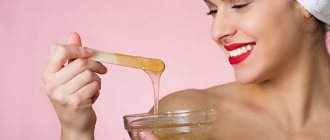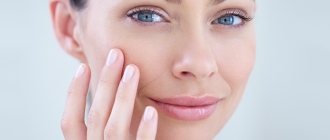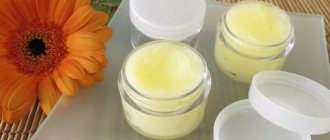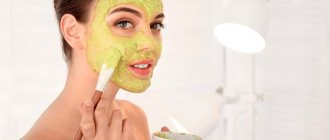What are alginates
To understand what an alginate mask is, you need to understand the very definition of “alginate”. Alginate is a plastic, rubber-like substance obtained from brown algae. It is this that serves as the basis for the masks of the same name.
Alginate masks are a professional cosmetic product that demonstrates good results. You can find a unique composition for any skin type and for any problem. Well, due to the fact that all alginate masks have a bright tightening effect, ladies over 30 simply need to use them.
In a salon, applying an alginate mask can cost 1–2 thousand rubles, but if you carry out the procedure at home, then one portion of a wonderful product will cost only 200–300 rubles.
What result
Correct use of the mask guarantees an almost salon effect . It all depends on the cosmetic product you choose in the store and its fundamental characteristics and composition. The result of responsible use of funds is:
- Deep hydration and formation of proper nutritional conditions for the skin.
- Cleansing the dermis of impurities and pores, as well as its general detoxification.
- Neutralization of redness and various inflammatory processes. Fight acne.
- Constriction of blood vessels and capillaries. You will gradually begin to forget about the problems of the so-called spider veins on the skin.
- Stabilization of the sebaceous glands and neutralization of oily stains from the surface of the dermis.
- Formation of an impeccable balance of vitamins and minerals directly at the cellular level.
- Creating additional protection for the dermis.
- Toning, smoothing wrinkles and correcting the oval of the face, which leads to an overall effect of rejuvenation.
- Removing excess fluid, allowing you to relieve swelling under the eyes and create lymphatic drainage.
Types of alginate masks
Classic (basic) mask based on alginates
It is most popular and widely used by girls with any skin problems, from enlarged pores to increased oily skin. To use it, you need to mix two components: alginate with a special serum, and sometimes with regular mineral water. This mask will moisturize, tighten, give the skin elasticity and youth.
Rejuvenating alginate mask
Its main function is to stop skin aging and make it fresh. The collagen included in the composition gives the epidermis elasticity and firmness, due to which shallow wrinkles are smoothed out. An additional purpose of such a mask is to moisturize the skin of the face and décolleté, as well as lifting.
Moisturizing alginate mask with added chitosan
Chitosan is an amino sugar that is extracted from shelled crustaceans. This mask can be used even in the most advanced cases of peeling and dryness. It is able to even out the contour of the décolleté, neck, chin, cheeks, and also moisturizes the skin abundantly.
Alginate mask with ascorbic acid
This mask is a real salvation if you have age spots or if your skin needs to be lightened. It will give your face an even color and a pleasant blush.
Alginate masks on various plant bases
Added plant extracts successfully solve various skin problems. Chamomile, ginger, green tea, mint, aloe will specifically fight imperfections.
Recommended for:
An important feature of the alginate mask is its versatility - it is equally good for all skin types and has no age restrictions. The mask is suitable as a “SPA” procedure for the whole body, but most often it is used to nourish and moisturize the skin of the face.
What can an alginate mask do?
- Fights excess fat deposits. It is effective as a remedy for “orange peel” - the effect becomes noticeable after just a few sessions. Actively breaks down subcutaneous fat and corrects the natural production of sebum. The facial contour is smoothed out, becoming clearer and more beautiful.
- Smoothes out scars and stretch marks. Copes well with “traces” of acne and blackheads.
- Treats skin from acne and blackheads. Deeply cleanses and “sucks out” dirt and sebaceous plugs from the pores, removes toxic substances from the skin. The skin begins to breathe easier, metabolism improves. The mask helps narrow enlarged pores and reduces the risk of new impurities and inflammation.
- Visibly rejuvenates. And inhibits the aging process of the epidermis. Alginate masks prevent early aging and “wear and tear” of the skin by activating cell regeneration processes and nourishing the skin with useful substances and elements.
- They calm you down. Cleans up reddened and irritated skin, treats inflamed areas. Returns a healthy and beautiful color to the face.
- Relieves swelling. Eliminates “puffiness”, the face becomes thinner and acquires clear contours.
- Tightens and tones. Blood circulation improves, the skin is noticeably refreshed, flabby or sagging areas are tightened. Muscle tension is relieved, which helps the disappearance of fine wrinkles. And this, in turn, has a positive effect on our mood and well-being. Scientists have found that constant tension in the facial muscles causes increased tone of various muscles of the body. Therefore, if you want to relax and unwind, start by taking care of your face.
Differences between alginate and non-alginate masks
Kazmulka/Depositphotos.com
Are alginate masks really somehow critically different from any others or is it just a marketing ploy?
If we talk about the most common masks produced by cosmetic concerns, they are unified. Developed - tested - sold. This means that everyone will buy them, they are inexpensive, easy to use, and whether they will help or not is a matter of chance, although at the testing stage they showed some results in relation to the existing problem.
Alginate masks are not much different from the most common ones, except that they must be prepared from the proposed ingredients, and the process of application and removal is more complicated. That is why alginate masks are considered professional cosmetics and in salons they are applied according to all the rules so that there is a truly noticeable result. These masks work better when applied systemically, largely due to the properties of alginates, which provide a rejuvenating effect.
Therefore, if you are planning to buy an alginate mask and use it at home, then the price-quality ratio is quite reasonable, and you will be more satisfied with the results than when buying the simplest face mask for the same money.
Applying a mask in 7 stages
To apply the mask you will need a rubber bowl and a spatula.
1. First of all, you need to put the required amount of alginate in a bowl.
2. Then, unless otherwise indicated, dilute the powder with clean water at room temperature in a ratio of 1:3 (1 part mask and 3 parts water) and mix thoroughly with a spatula for 2 minutes.
3. You must put a disposable cap on your head to prevent the composition from getting on your hair.
4. It is recommended to apply the alginate mask while lying down, which is very difficult to do on your own, so ideally, of course, it would be good to train someone at home to apply the alginate mask to you.
But if you are forced to apply the mask yourself, then it is best to do it while standing in front of a large mirror and tilting your head back slightly.
The mask should be applied with quick movements along massage lines from the center of the face to the periphery, leaving only the nostrils open. If you hesitate, the mask will begin to harden in the bowl and you will not be able to apply it.
You may not be able to do it quickly enough the first time, but over time you will learn how to apply such a mask without problems.
The second eye should be covered with a mask last, and it is advisable to do this not far from the sofa on which you are going to lie down.
After 5-7 minutes, when the composition has hardened, you can apply any moisturizing or nourishing cream along the edges of the mask. This will prevent the edges of the mask from drying out, and will make it easier for you to remove it later.
5. The alginate mask is left on the face for 20-25 minutes, during which time it is better to listen to pleasant music and try to relax. However, if you are alone at home, be sure to set a timer on your phone before applying the mask.
6. After 20-25 minutes, first slightly detach the edges of the alginate along the contour, then pick it up by the edges and carefully remove the mask from bottom to top. If the alginate is of high quality, then the mask does not tear, but is quite easily removed in one layer. And the remnants of the mask at the edges can be removed using a cotton pad soaked in tonic.
7. At the end of the procedure, you need to apply your daily face cream to the skin. And if you are planning to go out, then in just a few minutes you can start applying makeup.
Features of alginate masks
1. The finer the powder the dry mask is, the higher its quality. If the powder is more like sand, then such a mask will not fit well on the skin and form lumps.
2. A gel alginate mask does not dry out like a powder mask and is washed off with just plain warm water. It is convenient to take it on the road or use it in cases where it is not possible to dilute powder.
3. There are practically no allergies to alginate masks. They contain only one allergen - iodine, extracted from algae. Therefore, if you are allergic, but you are not allergic to iodine, then feel free to use alginate masks - everything will be fine.
In what cases is the product not suitable?
Alginate face mask is known as a natural and safe remedy for the skin of the face and body. It can be applied to the delicate skin of the lips, the area around the eyes and the upper eyelids. The mask is gentle and will not harm even these sensitive areas. A healthy person has nothing to worry about, but there are precautions that need to be taken into account before using this “sea” remedy.
- Allergies and individual intolerance. This is practically the only limitation for using an alginate mask. To test your skin for an allergic reaction, simply apply a small amount of the prepared substance to a small area of skin, for example, on the inside of your elbow or wrist. If there is no redness or other changes on the epidermis within an hour, you can safely use the mask.
- Conjunctivitis and other eye diseases. If you have any eye diseases, they are very tired or irritated - then the mask is used with caution, without applying to the skin of the eyelids and the area around the eyes.
- Acne or multiple pimples. Contraindication applies to severe skin inflammation and irritation.
During pregnancy or lactation, the body undergoes frequent hormonal surges and changes. The body can react unusually to even the most ordinary things, not to mention a new drug or cosmetic procedure. Therefore, before using an alginate mask during this delicate period, you should definitely consult a doctor. Contraindications also include cancer.
How to use alginate masks correctly
If in front of you is a bag with gel-like contents, then you bought an alginate mask that is ready for use. It has a shorter shelf life and must be applied immediately after opening the package, otherwise after 5-7 minutes it will become more like rubber and it will not be possible to apply it. Make sure that the bag is tightly sealed, because if air gets into it, then such a mask will not last long.
You can apply an alginate mask no more than twice a week, and to achieve the best results, it is recommended to carry out a full course. Depending on the manufacturer and individual skin characteristics, this can be from 7 to 20 masks.
Do not attempt to flush a mask removed from your face or body down the toilet or sink. It should only be thrown into the trash bin, otherwise you are guaranteed to get clogged.
If you decide not to go to the salon, but to make a mask at home, then buy a special bowl with a cosmetic spatula to mix the contents.
Before diluting the alginate mask, prepare your face in advance so that the mass does not have time to dry out.
Interesting history and application
What an alginate face mask is became known not so long ago. Alginic acid salts were discovered in the same way that most of the most exciting scientific discoveries are made - that is, completely by accident. The discovery was made at the end of the twentieth century, when in his experiments the American biochemist Moore Stanford extracted iodine from algae. During the experiments, the famous scientist obtained an unusual by-product - alginate. Its careful study bore fruit: it turned out that the substance has the most valuable properties for our body.
Gradually, alginates were introduced into a variety of areas of application, from medicine to the food industry, and eventually reached the beauty industry. Doctors successfully use them to treat various diseases of the stomach and intestines. In the food industry, the substance plays the role of safe food additives. These are the same stabilizers and thickeners, also known as “eshki”, which you don’t have to worry about - E401, E402, E404.
In addition to their basic properties, alginates are also adsorbents. They can absorb a mass of water many times greater than their own. This ability makes them a valuable basis for a cosmetic mask - they literally “pull out” excess water, due to which the mineral balance of the skin is normalized and puffiness goes away. And this is far from the only cosmetic property that alginate masks can boast of.
Important: do not confuse “alginate” mixtures with “aldehyde” face masks! These are two completely different substances. If sodium alginate is of marine origin, then the basis of the aldehyde mask is formic acid and retinol, or vitamin A. It is impossible to prepare this substance at home; it is obtained only in chemical laboratories. Ready-made aldehyde face masks are available for sale.
How to apply alginate masks
HannaNes/Depositphotos.com
Cleanse your face
This is where makeup remover milk, micellar water, or any other product you use will help you. Treat your eyebrows and eyelashes with Vaseline or the thickest cream you have in your arsenal. To ensure that the alginate mask penetrates deep into the skin, you can steam your face and apply an emulsion.
Apply the mask itself
It is recommended to do this only after the emulsion has been absorbed. At this stage, take alginate powder and serum (if there is no serum in the kit and simple mineral water is needed to dilute the mask, take it in equal proportions) and mix. Apply the composition in a horizontal position; the muscles of your face and neck should not be tense. It is better to do this with a spatula, ideally taking into account the massage points. Do not try to apply the mask with your hands.
Alginate masks have a strong plasticizing effect, so they harden on the face within 5–10 minutes.
You will feel a feeling of tightness in the areas of application, it may feel like rubber has frozen on your face, but this is completely normal.
Remain in the original position for half an hour, after which the mask can be removed.
Take off your mask
Grab the free edge of the mask on your chin and lift it towards the hair area with a quick jerking movement. This process may cause some discomfort, but the results are worth it.
Treat your skin
To ensure your face reacts normally to the alginate mask, after removing it, apply your regular day cream that matches your skin type. The layer should be very thin.
How to do at home
Proper preparation of a professional product at home will require a competent and careful approach from you. Do not be afraid - if you carefully follow all stages of preparation, you will receive a product that is in no way inferior in terms of benefits and quality to the same one in a beauty salon.
Preparing the skin
A self-prepared powder mixture or a ready-made purchased gel hardens very quickly. You only have a few minutes to apply the product to your face, otherwise you may find that the mask has frozen right in the bowl. Therefore, you need to cleanse your facial skin and prepare it for the procedure before you take on the product itself.
Cleanse your skin with a special tonic or lotion for washing. If the skin is very flaky or suffers from numerous blackheads, you need to lightly exfoliate and remove the most obvious blackheads.
A regular scrub will help get rid of flaking. Steam your face a little with a damp hot towel, then massage the scrub onto problem areas of the skin. Actions should be unhurried so as not to damage the cover and make the procedure easy and enjoyable.
Immediately before starting the procedure with an alginate mask, you can wipe your face with cosmetic milk and apply a suitable serum to clean skin. This will improve skin tone and enhance the effect of the mask.
Blackheads must be removed at least several hours before applying the alginate mask. After the removal procedure, you need to allow the pores to return to normal and narrow so that infection does not enter the body through them.
“Pounding” the store-bought mixture
If you purchased a powder mask, you need to prepare it correctly. Usually, instructions and correct proportions are already written on packages or portioned bags of alginate. Unless otherwise indicated in the recipe on the package, the powder is diluted as follows:
- Pour the contents of one serving packet into a bowl.
- Pour approximately 70-80 ml of clean cold water into the powder.
- Mix thoroughly, the mixture should be free of lumps.
- As soon as you have mixed the mixture, you need to immediately take a lying position and start applying it to your face with a special spatula.
We “chemicalize” the mask ourselves
If for some reason you cannot purchase ready-made powder or gel, then you can prepare the dry mixture yourself. This will require some skill - you need to measure the proportions very carefully and not rush to dilute everything with water.
You will need
- A teaspoon of dry sodium alginate powder.
- Diatomite - three teaspoons. This substance is often not available in pharmacies. Then you can use its analogues, for example blue clay or pearl powder.
- Calcium sulfate or calcium chloride - just one ampoule. Plays the role of a plasticizer and thickener, giving the mask elasticity.
- Pure water.
How to cook
- Place the alginate in a bowl. Pour a small amount of warm water into it so that it completely covers the powder. Mix. Leave the mixture to “infuse” for five hours. Gradually it should become gel-like - to do this, stir the contents of the bowl occasionally. You can add water to it if necessary.
- When the alginate has reached the desired state, take another clean bowl. Now you need to dilute diatomaceous earth or the selected substitute with water. Add water a little at a time, the end result should be the consistency of thick sour cream.
- Mix the contents of the second bowl with the prepared alginate gel.
- Now it's calcium sulfate's turn. After adding it to a bowl with the substance, you need to mix everything very quickly and immediately begin applying the mask to your facial skin, otherwise it will harden right in the container.
- It would be a good idea to have someone else help you so that you are ready to use the mask immediately.
Contraindications
Alginate masks are considered the safest. Their use rarely leads to allergic and other negative reactions.
However, their use is contraindicated in several cases:
- For oncological diseases;
- If you are intolerant to the components of the product;
- With increased sensitivity of the epidermis to low temperatures, as the alginate mask noticeably cools.
Compositions with alginate should not be applied to the areas near the eyes for conjunctivitis. It is not advisable to close your eyes for those who suffer from claustrophobia.
Masks with additives
As additives to the basic alginate mask you can use:
- Chopped shiitake mushrooms. Helps smooth out facial wrinkles.
- Dried kelp in powder form. Well moisturizes the driest skin, enhances the lifting effect of alginate. By the way, you can also make a mask from kelp.
- Mumiyo. Mountain balm does a good job of softening and reducing the visibility of scars, stretch marks, and scars on the skin.
- Pearl powder and Moroccan clay. These components have a brightening effect and reduce the visibility of hyperpigmented spots.
- Argan oil. Nourishes depleted and sensitive skin.
- Tea tree oil. Repeatedly enhances the anti-inflammatory effect of alginate, relieves acne and rashes.
- Chamomile extract. Can be used as an additional component if acne bothers you.
- Rose oil. Normalizes the production of skin secretions, dries out oily skin.
- Blueberry fruit extract. It is used if it is necessary to cope with age spots.
- Nutmeg. Under its influence, the pores are well cleaned, after which they narrow.
- Chocolate. Refreshes the skin, softens it, gives radiance.
You can fortify an alginate mask by adding 2-3 drops of liquid vitamins, such as A, E, C or D. Some girls first distribute these vitamins over the face and only then apply the basic alginate mixture.
What do you need for skin care every day?
The procedure for caring for facial skin changes every day as the body grows older:
- 20+. During this period, the withering processes begin and the first signs of skin maturity appear. Daily skin care after 25 years is based on the use of moisturizers and antioxidants. The skin is still elastic and actively regenerates. Therefore, daily skin care after 25 is limited to the use of products to cleanse and nourish the skin.
- 30+. At this age, the production of hyaluronic acid and collagen fibers significantly decreases, and the skin loses its elasticity. Fine wrinkles, traces of dehydration and sagging appear on the skin. A cosmetologist's advice on skin care after 35 is based on the use of antioxidant products and creams for ultraviolet protection, and anti-aging formulas with hyaluronic acid.
- 40+. Daily skin care after 45 is a comprehensive fight against age-related changes. By the age of 45, signs of aging, pigmentation, changes in facial contours, and decreased tone are noticeable on the skin. Tips from cosmetologists for skin care over 45 years old: replenish your cosmetic bag with products containing retinol, peptides, and hyaluronic acid.
- 50+. Daily home care for facial skin after 50 years should be carefully planned. During this period, hormonal imbalance is noted - collagen synthesis stops, skin tone decreases. At the age of 50+ you cannot do without compensatory care. A cosmetologist's advice for skin care after 55 years is to use anti-aging formulas with a powerful effect, aimed at replenishing the lack of moisture and collagen fibers.
How to care for your skin depending on its type?
Oily and combination skin suffers from intense production of sebum. The skin has a characteristic oily sheen, which is especially noticeable in the area of the nose, forehead and chin.
Daily care for problem skin is based on the use of products with a mousse texture that are washed off with water. Such products do not disturb the balance of the skin. To care for problem skin, it is better not to use abrasive products - they aggressively cleanse the skin and injure the epidermis.
Every day care for problematic facial skin is based on the main rule - proper cleansing. You need to take care of your skin with gels and small scrubs. They eliminate impurities and dead particles of the epidermis, cleanse pores, and eliminate clogging of the sebaceous glands. Daily care for problem skin necessarily includes refreshing your face with tonic. Products should contain a lot of moisture, but not be too greasy.
Combination skin is characterized by a combination of two skin types. The so-called T-zone is distinguished by an oily sheen, often with inflammatory foci. There are dry areas in the cheek area. Combination skin becomes treacherously shiny in the summer heat, but dries out quickly in winter. What should be your daily facial skin care routine at home?
There is no need to use different products for different areas of the face! Today, cosmetics have been developed for mixed skin types. Daily facial skin care involves the use of soft toners and low-fat creams. Mattifying wipes can get rid of excess fat in the T-zone, and toner can normalize the pH of the skin.
Dry skin suffers from a lack of sebum and moisture. The skin looks thin, stretched and rough. Dry skin is prone to premature wrinkles. Products with an oily, rich texture will help restore comfort and beauty to your skin.
A cosmetologist's advice on caring for dry skin is based on hydration and nutrition. Daily care for dry skin at home involves the use of delicate products that have a mild moisturizing effect.
Daily care for dry skin should include soft milk, gentle tonics, and nourishing creams with herbal extracts. Such products will restore healthy radiance and beauty to the skin. Products containing irritating alcohol and abrasive particles should be excluded from daily care for dry skin.
Daily care for aging skin has its own characteristics. Often women aged 35+ experience loss of elasticity, the appearance of thin skin folds, dryness and sagging.
Daily facial skin care at 35 years old is based on replenishing the lack of collagen and elastin, stimulating cells to self-heal. Naturally, it will not be possible to stop the aging process. But they can be significantly slowed down. Daily skin care after 45 should consist of products containing hyaluronic acid and collagen. Anti-aging cosmetics will make the skin more elastic, tightened and nourished.
Where is sodium alginate sold?
The basis of this mask is sodium alginate. This is a fine powder of a rich white hue, which is sold in pharmacies, stores selling cosmetics, or ordered online. Sometimes alginate can also be purchased from nutritional supplement suppliers.
The powder is sold in packages of 25, 50, 100 and more grams. The cost of a 100 gram package averages 250-300 rubles. Sodium alginate should be stored in tightly closed containers in dry places.
General indications for use
As already mentioned, alginate masks are universal, that is, they can be used to normalize the structure of dry, sensitive, oily and normal skin.
A course of procedures will help cope with such defects on the face as:
- Scars and marks after acne.
- Dark spots.
- Cuperosis.
- Increased sagging skin.
- Small wrinkles.
- Edema.
Products with a simple composition are suitable for preventing the appearance of early wrinkles and other age-related changes. They can be used to moisturize the skin after it has become dry, for example, after prolonged exposure to the sun.











